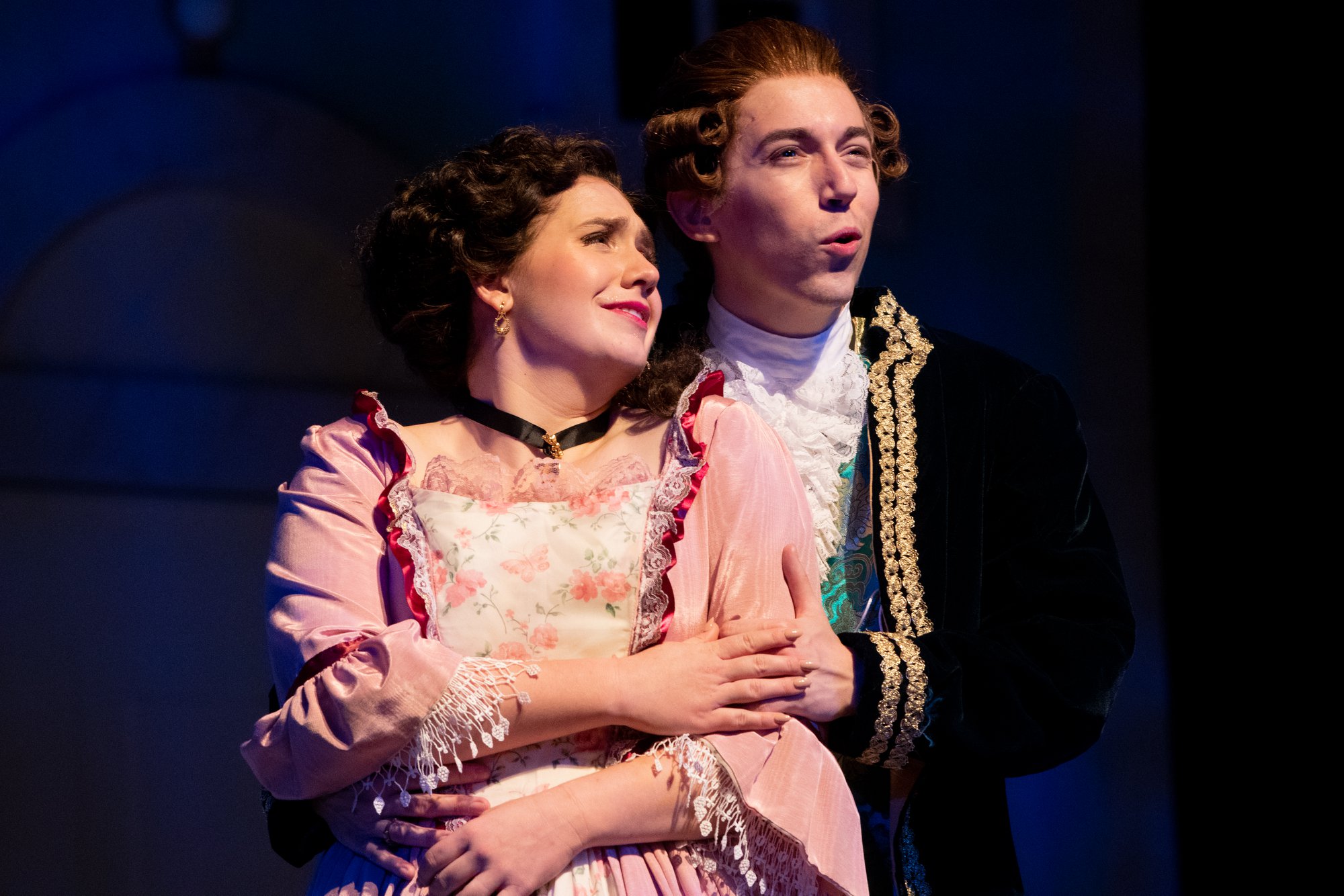Annapolis Opera’s production of The Barber of Seville is a hilarious spectacle of a show. Directed by Braxton Peters, with Artistic Director Ronald J. Gretz conducting, it combines beautiful music and singing with excellent acting and choreography, as well as inventive lighting. With memorable music and a comic story, Rossini’s 1816 opera is a delightful way to temporarily forget the world’s cares.

Scott Purcell plays Figaro, the title character, full of joyful energy. He leaps onto the stage singing his entrance aria “Largo al factotum,” hitting the famous repeating of his name to great applause. The jingle of Count Almaviva (Jonas Hacker)’s coins gets him plotting in “All’idea di quel metalle,” his fingers whirling as he paces the stage. Trying to distract Doctor Bartolo (Brandon Hendrickson) from the lovers’ conversation, he applies lather to Bartolo’s face, and sits on his lap. While the Count and Rosina (Hannah Ludwig) embrace and sing of their love, he makes motions for them to escape.
Jonas Hacker gives a romantic contentment to Count Almaviva. He sings to Rosina’s balcony window with a smile on his face in “Se il mio nome,” clear and determined in his love. Hacker plays the Count’s two disguises with great comedy. As the drunken soldier Lindoro, he staggers around, chasing the maid (Kylena Parks). He embraces Bartolo as the Doctor pushes him away, and holds his papers close to the Doctor’s face. He draws his sword and lunges at Bartolo. As the music teacher Don Alonso, he sings repeatedly of “peace, joy, and contentment” in a comically high-pitched voice to Bartolo’s annoyance, while bowing and whispering into the Doctor’s ears. It is pure joy watching him take on all these roles.
Hannah Ludwig gives Rosina a romantic slyness. Her first appearance, behind the French doors of her balcony, she sings hauntingly. In “Una voce poco fa” she declares her determination to win her suitor, while reminding herself that she is “a viper…if they touch her in the wrong places.” At the end, she hurls the pillow off stage. She shows her cleverness to Figaro in “Dunque io son,” coyly responding to his suggestion of writing a letter to the Count before revealing one she already wrote; they applaud their cunning with bows. During her secret declaration of love to the Count, she holds Bartolo’s hand before snatching it away.
Brandon Hendrickson gives Bartolo excellent comedic arrogance. Questioning Rosina, he urges her in “Ora mi sento meglio” to “learn to lie better” as he imagines he can see right through her. Watching Rosina’s music lesson, he dozes off in the chair, waking with an exaggerated yawn. He inserts Rosina’s name into a classic aria, singing part of it before Figaro interrupts him.
Anthony Reed is a hoot as Don Basilio. He races across the stage in “La calunnia e un vincero,” shaking Bartolo and hurtling him to the floor in excitement. He ends draped over the couch in a painfully twisted posture, writhing in glee at his plans. Convinced he is sick by Figaro, Rosina, and the Count, he raises his arms like a zombie, before they toss him about the stage and hurl him out.
Kylena Parks plays Berta with joyful cynicism, singing of the others in “Il vecchietto cerca mogile” that they’re “all fit to be tied.” While cleaning up the mess, she sings of “dying an old maid” with a smile on her face. It is a wonderfully quiet moment in a busy production. Jason Buckwalter radiates authority as the Officer, questioning the loudly squabbling cast. As Fiorello, he is comically subservient, trying to move the band of musicians away from surrounding the Count.
Scenic Designer April Joy Vester does a wonderful job creating the set – a large, elegant home, with a balcony and tower. Act I shows the home from the outside, a bench in the middle of the courtyard. Acts II and III are inside the home, with a staircase leading to the balcony, a small sofa and table on the left and a desk and harpsichord on the right.

Costume Designer Lorraine vom Saal has made gorgeous period outfits. Figaro wears a long black jacket with a blue vest and tan shoes. The Count begins with long black boots and pants, a short black jacket, gray pants and a red vest, and ends in a black and gold fringed jacket, green vest, white pants and a large golden pendant draped around his neck. As Lindoro, he wears a bright red military jacket and a long gold sash around his waist, carrying a sword, while as Don Alonso, he wears a long black robe with a white scarf, as does Don Basilio. Rosina begins in a white nightgown, then changes into a maroon and white dress, and later a pink and white dress with red fringe.
Lighting Designer Michael Klima uses creative lighting effects. At the start of the opera, the set is bathed in blue light, as in darkness. When Figaro appears, the light brightens for morning. Lights shine from the inside of the French doors at Rosina’s showing. At the end of Act II, colored lights flash from the back, while white lights shine to resemble lightning between the scenes of Act III.
Ronald J. Gertz conducts the Annapolis Symphony Orchestra beautifully, the music coming through clear, projecting throughout the auditorium and blending perfectly with the actors’ voices. Braxton Peters does an excellent job as Director. The actors work well together, easily navigating the stage and each other. Their movement balances their singing, making for a vocal and visual delight. Their comic timing is spot-on, getting lots of laughs. Even non-opera fans would enjoy it.
Running Time: Approximately three hours, with two 15-minute intermissions.
The Barber of Seville, presented by Annapolis Opera, plays through November 4, 2018, at Maryland Hall for the Creative Arts – 801 Chase Street, Annapolis, MD. For tickets, call the box office at 410-280-5640 or purchase them online.




